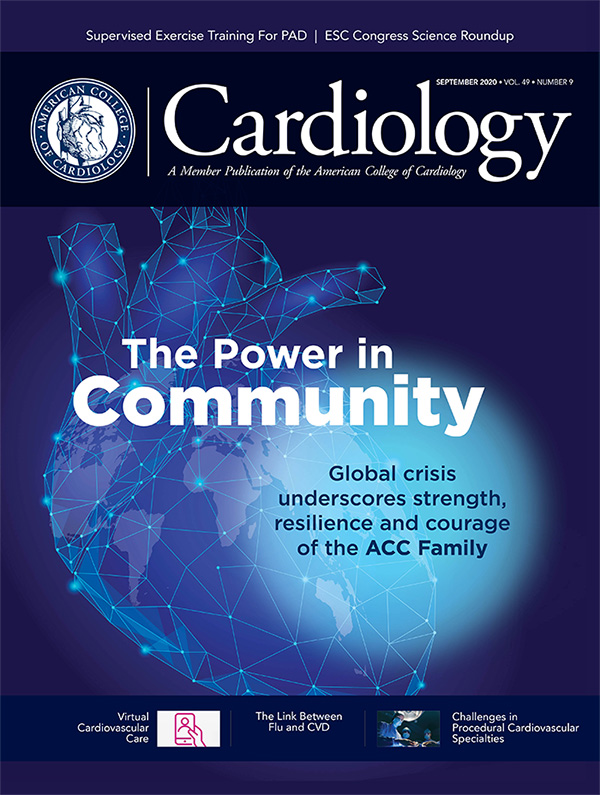CathPCI Registry: Guiding Practice
Informing Cardiovascular Clinical Practice With NCDR Data
In addition to helping hospitals, practices and clinicians advance the quality of cardiovascular care and improve patient outcomes, ACC's NCDR suite of registries are an important and robust source of data for practice-changing resource.
This month, Cardiology brings you a roundup of some of the most recent studies using NCDR data to shed light on topics ranging from improving patient outcomes following PCI to understanding of outcomes after TAVR in patients with aortic insufficiency.
In addition, two separate studies focus on geographic availability of TAVR and ways international benchmarking can inform global quality improvement efforts, respectively. Dive in and share your thoughts about the findings on Twitter using #NCDR and #CardiologyMag or join in discussions taking place on the ACC's LinkedIn page.

Multivessel vs. Culprit-Vessel PCI
Patients with acute myocardial infarction (AMI) and cardiogenic shock are increasingly undergoing multivessel PCI, but that may lead to poorer outcomes than culprit-vessel PCI, according to a study in JAMA Internal Medicine.
The study is part of ACC's Research to Practice (R2P) initiative, which identifies impactful cardiovascular research and analyzes implications for contemporary clinical practice.
Rohan Khera, MD, MS, et al., used registry data to evaluate use of multivessel PCI vs. culprit-vessel PCI and outcomes for both among U.S. patients with AMI and cardiogenic shock between 2009 and 2018.
The study's primary outcome was in-hospital mortality. For secondary outcomes, the researchers analyzed the association between PCI strategy and postdischarge outcomes in a subset of patients who were Medicare beneficiaries.
The final study cohort consisted of 64,301 patients with AMI and cardiogenic shock. Of these, 48,943 patients (76.1%) presented with STEMI, and 15,358 (23.9%) presented with NSTEMI. Among all patients, 22,418 patients (34.9%) received multivessel PCI and 41,883 (65.1%) underwent culprit vessel-only PCI.
Among STEMI patients, 15,394 (31.5%) received multivessel PCI. During the study period, use of multivessel PCI increased by 55% in patients with cardiogenic shock, 55% in STEMI patients and 53% in AMI patients overall.
Among patients with STEMI and cardiogenic shock, multivessel PCI was associated with higher in-hospital mortality (risk-adjusted odds ratio [OR], 1.11; 95% confidence interval [CI], 1.06-1.16; p<0.001).
Among the overall AMI population, including both STEMI and NSTEMI patients, multivessel PCI was associated with lower risk-adjusted mortality (risk-adjusted OR, 0.96; 95% CI, 0.92-0.99; p=0.02).
In the overall AMI population, after adjusting for pre-PCI characteristics – including demographics, comorbidities, clinical presentation in the catheterization laboratory and disease severity – use of multivessel PCI was associated with increased odds of one or more complications vs. culprit-only PCI.
In the subset of 18,142 Medicare beneficiaries who were followed long-term, one-year mortality was 51.5% among patients who received multivessel PCI vs. 49.8% in patients who underwent culprit vessel-only PCI.
According to the researchers, the study "highlights opportunities to improve care practices" for patients with AMI and cardiogenic shock. They conclude that multivessel PCI is associated with poorer outcomes and in-hospital morality, particularly in STEMI patients, without evidence of improved long-term outcomes.
The findings are a reminder that "interventions that are conceptually sound and delivered with the best of intentions do not always stand up to empirical testing and may carry unintended harms," Colette DeJong, MD, and Rita F. Redberg, MD, FACC, write in an editorial that accompanied the study.
"Despite our good intentions, it is clear that primary nonculprit PCI for patients with acute MI in cardiogenic shock does not benefit and can harm, and the practice should be abandoned for patient safety," they conclude.
Bleeding Avoidance Strategies
Transradial intervention (TRI) may be associated with decreased PCI-associated bleeding across different risk groups, based on findings from a study published in Circulation: Cardiovascular Interventions.
Led by Ty J. Gluckman, MD, FACC, researchers compared the impact of three bleeding avoidance strategies (BAS) – procedural anticoagulation with bivalirudin (BIV), TRI, and use of a vascular closure device (VCD) – and used the CathPCI Registry's bleeding model to assess bleeding risk, stratifying 74,953 procedures into six categories based on bleeding risk. The primary endpoint was post-PCI bleeding, based on the CathPCI Registry definition of suspected or confirmed bleeding events within 72 hours of PCI.
Overall, the bleeding rate was 4.4%. Bleeding was highest in procedures using no BAS (9.6%) and lowest in those using BIV and TRI (1.7%). As bleeding risk increased, crude bleeding rates rose from 0.2% to 2.2% in the first quartile to 23% to 39% in the top 2.5th percentile.
The researchers also looked at the odds of bleeding between BAS in each risk category. The odds of bleeding were lower across all risk groups for BIV and VCD (95% CI, first quartile, 0.36 (0.18-0.72) to top 2.5th percentile, 0.50 (0.32-0.78) and TRI alone (95% CI, first quartile, 0.15 (0.06-0.38) to top 2.5th percentile, 0.49 (0.28-0.86).
According to the researchers, the findings provide "strong support for TRI, without the addition of BIV, as the preferred BAS."
Although quality improvement initiatives focused on use of BAS have led to a reduction in bleeding rates, the difference in bleeding rates based on BAS suggests a different approach is needed, they write, adding, "Simply put, it is not just about using any BAS – it is about using the right BAS."
PCI of LIMA vs. Other Graft Types
Patients undergoing PCI of the left internal mammary artery (LIMA) may have lower rates of recurrent MI and repeat revascularization after one year, compared with those undergoing PCI of other arteries, according to research in the Journal of Invasive Cardiology.
Khung-Keong Yeo, MBBS, FACC, et al., linked more than 1 million patient records to claims data from the Centers for Medicare and Medicaid Services (CMS) to compare outcomes, placing patients into one of three groups based on graft type – LIMA, saphenous vein graft (SVG) or other.
Primary outcomes were procedural success and one-year mortality; secondary outcomes were one-year rates of rehospitalization for MI, stroke and unplanned repeat revascularization.
The results showed similar procedural success across the three groups (91.1% for LIMA, 92.9% for SVG and 93.4% for other). After one year, mortality was 14.8% for LIMA, 16.6% for SVG and 11.8% for other grafts.
In terms of secondary outcomes, the rates of one-year MI rehospitalizations were 6.6% for LIMA, 9.9% for SVG and 8.1% for other grafts. Repeat revascularization occurred in 9.5% of LIMA patients, 14.4% of SVG patients and 10.4% of other patients.
Despite similar procedural success rates, the study demonstrates an association between LIMA procedures and lower rates of MI and repeat revascularization after one year, according to the researchers.
Comparing PCI Volume in US, Japan
Another recent CathPCI Registry study compared PCI procedural volume, preprocedural testing, patient and procedural characteristics, and quality metrics in the U.S. and Japan, illustrating how such comparisons can identify potential opportunities to build on quality improvement efforts in both countries.
Taku Inohara, MD, PhD, et al., used data from the CathPCI Registry to look at nearly 3 million PCIs performed in the U.S. between 2013 and 2017 and the Japanese PCI Registry, evaluating more than 1 million PCIs performed in the same time period in Japan.
The study, published in the Journal of the American College of Cardiology, shows that PCI volume has increased in both countries but that elective cases are driving the increase in Japan.
During the study period, PCI volume increased by 15.8% in the U.S. and by 36% in Japan. The increase was driven primarily by nonelective PCIs in the U.S., although the number of elective PCIs also rose, while the increase in Japan was primarily due to elective procedures. Overall, the proportion of elective PCIs was 33.8% in the U.S. vs. 72.7% in Japan.
In Japan, patients undergoing PCI were older; more likely to be male; and had lower prevalence of hypertension, dyslipidemia, chronic lung disease and peripheral artery disease than U.S. patients.
PCIs for acute coronary syndromes were less common in Japan (39.3%) than the U.S. (81%), particularly for STEMI and unstable angina. Other demographic characteristics were comparable between patients in the two countries.
In general, adherence to quality metrics was higher in the U.S. than in Japan. Median door-to-balloon time was 57 minutes in the U.S. vs. 71 minutes in Japan. Observed in-hospital mortality rates were about 2% in the U.S. and about 0.8% in Japan.
Use of antiplatelet therapy was "well-implemented" in both countries, but the transradial approach was more common in Japan than in the U.S. In both countries, expected mortality rates increased over the study period.
The study's findings suggest "there are still important opportunities to further improve the quality of PCI in both countries," according to the researchers.
"Continued efforts towards international benchmarking can yield insights on global variation in care, and may be helpful in developing quality improvement efforts," they conclude.
In an accompanying editorial comment, Harold L. Dauerman, MD, FACC, and Michael J. Mack MD, MACC, write that it is unclear what is driving increased PCI volumes in the two countries, noting that the "relentless march of new percutaneous technology and advances in structural heart disease may continue to shape the culture of coronary artery disease treatment."
As new evidence emerges it will be "critical" for international registries to "monitor the impact of these competing influences on clinical practice and patient outcomes," they conclude.
Clinical Topics: COVID-19 Hub
Keywords: ACC Publications, Cardiology Magazine, COVID-19, Prevalence, Pandemics, severe acute respiratory syndrome coronavirus 2, Social Change, Developing Countries, Cardiovascular Diseases, American Heart Association, World Health Organization, Politics, Registries, Myocardial Infarction, Morbidity, Global Health
< Back to Listings

